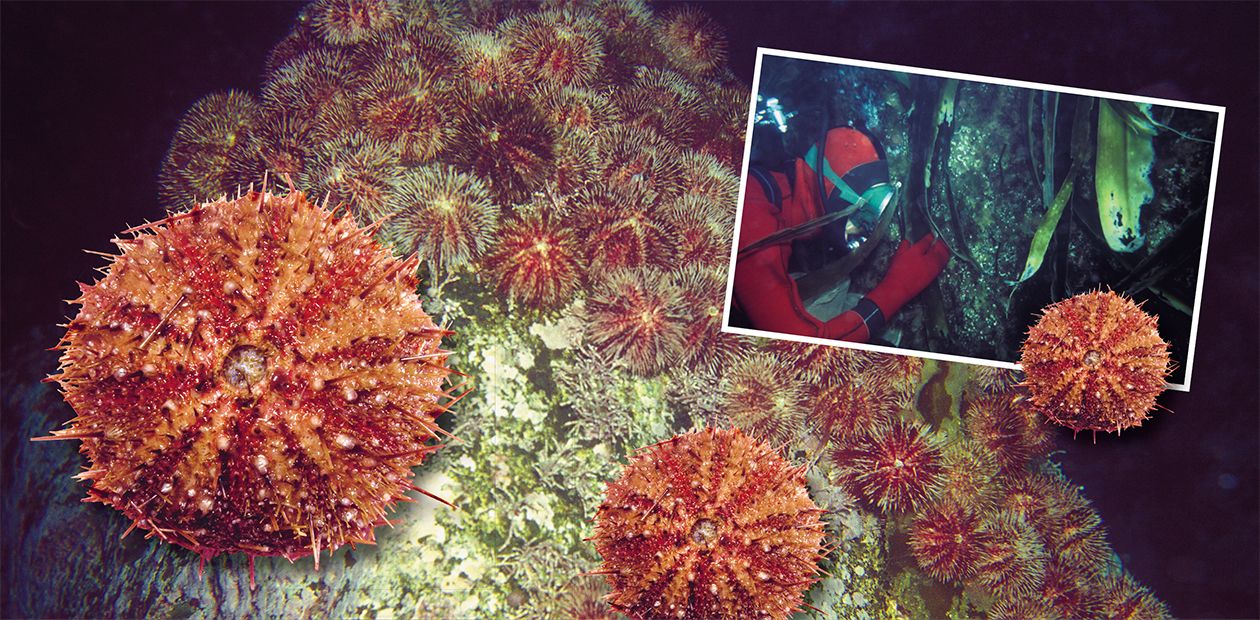Sea Urchin Caviar
The Japanese live long and healthily — they remain active and alert long after the official retirement date. So it is not surprising that our nutrition specialists regard traditional Japanese food as being “packed” with extremely useful substances...
Though, the Japanese themselves (including nutritionists and specialists in public health) often can hardly guess what extraordinary disease-curing properties are attributed to their food by their Russian colleagues.
And the more expensive the food is, the more beneficial it is supposed to be. For example, the quote unit price for the grey sea urchin harvesting is 6000 rubles (ca 200 US dollars), which is twice more expensive than that for the Pacific salmon and six times more expensive than that for squids. So from here the conclusion is drawn that eating sea urchin should be exclusively beneficial.
One can eat the eggs and roe of this prickly delicacy. In Japan it is called “uni”, in Russian – “sea urchin caviar” (yes, not eggs, but caviar — the same word as for the salmon and sturgeon caviar!). Forty- fifty years ago one could easily buy “sea urchin caviar” at any seafood shop or fish stall in the former Soviet Union. Today most of the harvest is exported to Japan, where people, as we know, leave happily ever after…
But really, does “sea urchin caviar” influence mammalian health that significantly, or is it just yet another myth on the “forever lasting youth” elixir? Djungarian hamsters, the traditional object for the physiological studies, became the “laboratory rabbits” in the studies. During a month a control group of one-year-old hamsters (grandfather’s age for the hamster!) additionally to ordinary food ration were fed with fresh curd (1.5 g daily). An experimental group was getting the same curd, but with “sea urchin caviar” additions (1.2 % of the curd weight).
Such an “insignificant” addition to the ration of the experimental group nevertheless led to quite remarkable results. Firstly, the hamster motoric activity was increased. Despite the increase in spent energy, active consumers of the “sea urchin caviar” managed to gain some weight, while the control group maintained their weight almost without any change. In addition to these obvious differences, we have found that the “sea urchin caviar” consumption positively influences the immune and endocrine systems. In the experimental hamster group with the gourmet “sea urchin caviar” cuisine, the immune response to foreign antigens was more intense. Also, the proportion of males with a high level of testosterone was higher in the experimental group.
It is known that in mammals (including humans) aging manifests itself in decelerating the growth, decreasing the motorics, declining the immunity and endocrine function of the gonads. Our experiments have proved that such manifestations may be partly overcome by eating small amounts of the “sea urchin caviar”. Unfortunately the “sea urchin caviar” is rather expensive. And the population of these sea creatures is not particularly great — as compared to the number of eager consumers.
Thus, the identification of bio-active agents in the “sea urchin caviar” and their industrial manufacturing should be done not only for the healthcare sake, but also for the environmental protection. We should be very careful in spending this generous “present” of the Mother Nature, so that the prickly “youth elixir” should not become extinct!
Professor M. P. Moshkin (Institute of Animal Systematics and Ecology, Siberian Branch of the Russian Academy of Sciences, Novosibirsk, Russia)
Sea Urcin Life Facts
Sea urchins are quite well known with the indigenous inhabitants of the sea coasts across the world. Unfortunately for urchins, the interest always had a definite ”gastronomic flavor”. The main reason of such high interest towards the urchins is in their eggs, as it is with the ” Kashchei The Immortal” (a character of famous Russian fairy tales, his ”death” was hidden in an egg).
Deep- orange radial ”caviar” segments take about 20 % of the internal organs of this sea creature. One can argue about the taste and smell of this delicacy, but Salvador Dali advised his fellow painters to eat three dozens (!) of sea urchins, better if they were caught two days before full moon, to reach inspiration.
When the sea urchin is not considered as a sandwich component, one can find a lot of interesting in the life of these unusual sea creatures. For example, sea urchins can be grey and pale, black and green, and also flat, prickly, multi-spine — more than 900 species altogether. Some short-spine sea urchins have retractable pincers, secreting a poison… Some red sea urchins possess a secret of surprising longevity!
We should better stop now, referring inquisitive readers to the paper about a complex life of this interesting creature that will be published in the next issue of our journal. Its author is Yu. M. Yakovlev, Ph. D. in Biology from the Institute of Marine Biology, Vladivostok, Russia, and his knowledge about sea urchins is not hearsay. He is not only a marine biologist, but also a professional diver and a brilliant photographer.











